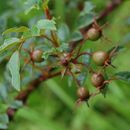Associations
provided by BioImages, the virtual fieldguide, UK
Foodplant / parasite
fruitbody of Ganoderma australe parasitises live trunk of Rosa longicuspis
Comments
provided by eFloras
One of us (Robertson) would prefer not to recognize varieties in this species, and notes that the distinguishing characters given below are not those used by Rehder (Man. Cult. Trees, ed. 2, 447. 1940, as species).
- license
- cc-by-nc-sa-3.0
- copyright
- Missouri Botanical Garden, 4344 Shaw Boulevard, St. Louis, MO, 63110 USA
Description
provided by eFloras
Shrubs usually evergreen, climbing or scrambling, 1.5–6 m tall. Branchlets purple-brown; prickles sparse or scattered, curved, to 5 mm, stout, flat, gradually tapering to a broad base. Leaves including petiole 7–14 cm; stipules mostly adnate to petiole, free parts lanceolate, often glandular-pubescent; rachis and petiole glabrous, with a few hooked prickles; leaflets 5–9, ovate, elliptic, or ovate-oblong, 3–7(–11) × 1–3.5(–5) cm, leathery, both surfaces glabrous, abaxially with prominent midvein, adaxially shiny, rugose or not, base subrounded or broadly cuneate, margin acutely serrate, apex acuminate or long acuminate. Flowers numerous, in corymb, 3–4(–5) cm in diam.; pedicel 1.5–3.5 cm, sparsely pubescent, densely glandular-pubescent; bracts ovate-oblong, margin glandular-pubescent. Hypanthium ovoid or obovoid, sparsely pubescent and glandular-pubescent. Sepals 5, deciduous, lanceolate, 0.8–1.2 cm, both surfaces pubescent, abaxially intermixed with glandular hairs, margin entire or few pinnately lobed, apex long acuminate. Petals 5, fragrant, white or creamy-white, broadly obovate, abaxially sericeous, base broadly cuneate, apex erose. Styles connate into column, exserted, slightly longer than stamens, pubescent. Hip dark red, obovoid, 1–1.2 cm in diam., glabrous; sepals reflexed, deciduous at hip ripening. Fl. May–Jul, fr. Jul–Nov.
- license
- cc-by-nc-sa-3.0
- copyright
- Missouri Botanical Garden, 4344 Shaw Boulevard, St. Louis, MO, 63110 USA
Distribution
provided by eFloras
Guizhou Sichuan, Yunnan [N India].
- license
- cc-by-nc-sa-3.0
- copyright
- Missouri Botanical Garden, 4344 Shaw Boulevard, St. Louis, MO, 63110 USA
Habitat
provided by eFloras
Mixed evergreen forests, thickets, scrub, dry open areas; 400--2700 m.
- license
- cc-by-nc-sa-3.0
- copyright
- Missouri Botanical Garden, 4344 Shaw Boulevard, St. Louis, MO, 63110 USA
Cyclicity
provided by Plants of Tibet
Flowering from May to July; fruiting from July to November.
Diagnostic Description
provided by Plants of Tibet
Rosa longicuspis var. longicuspis is close relative of Rosa longicuspis var. sinowilsonii, but differs from the latter in its 7-9 (vs. 5 or 7) leaflets, not rugose (vs. slightly rugose) adaxially leaflets.
Distribution
provided by Plants of Tibet
Rosa longicuspis is occurring in Guizhou Sichuan, Yunnan of China, N India.
Evolution
provided by Plants of Tibet
Wissemann (2003) provided a subgeneric classification of Rosa, in which Rosa longicuspis belong to subgenus Rosa, section Synstylae DC. Both cpDNA (atpB-rbcL) and nuclear DNA (ITS) sequences unify the Asian sections Indicae and Synstylae into a consectional group (Wissemann and Ritz, 2005). In the analysis of Japanese wild roses by Wu et al. (2000) matK-DNA again merged both sections together. Mikanagi et al. (1995) showed similar flower flavonoid composition for Synstylae and Indicae.
General Description
provided by Plants of Tibet
Shrubs usually evergreen, climbing or scrambling, 1.5-6 m tall. Branchlets purple-brown; prickles sparse or scattered, curved, to 5 mm, stout, flat, gradually tapering to a broad base. Leaves including petiole 7-14 cm; stipules mostly adnate to petiole, free parts lanceolate, often glandular-pubescent; rachis and petiole glabrous, with a few hooked prickles; leaflets 5-9, ovate, elliptic, or ovate-oblong, 3-7 (-11) cm long, 1-3.5 (-5) cm wide, leathery, both surfaces glabrous, abaxially with prominent midvein, adaxially shiny, rugose or not, base subrounded or broadly cuneate, margin acutely serrate, apex acuminate or long acuminate. Flowers numerous, in corymb, 3-4 (-5) cm in diameter; pedicel 1.5-3.5 cm, sparsely pubescent, densely glandular-pubescent; bracts ovate-oblong, margin glandular-pubescent. Hypanthium ovoid or obovoid, sparsely pubescent and glandular-pubescent. Sepals 5, deciduous, lanceolate, 0.8-1.2 cm, both surfaces pubescent, abaxially intermixed with glandular hairs, margin entire or few pinnately lobed, apex long acuminate. Petals 5, fragrant, white or creamy-white, broadly obovate, abaxially sericeous, base broadly cuneate, apex erose. Styles connate into column, exserted, slightly longer than stamens, pubescent. Hip dark red, obovoid, 1-1.2 cm in diameter, glabrous; sepals reflexed, deciduous at hip ripening.
Habitat
provided by Plants of Tibet
Growing in mixed evergreen forests, thickets, scrub, dry open areas; 400-2700 m.
Morphology
provided by Plants of Tibet
Rosa longicuspis is here defined to included leaflets 7-9, leaves near corymb often with 5 leaflets, adaxially not rugose; flowers in corymbs.

